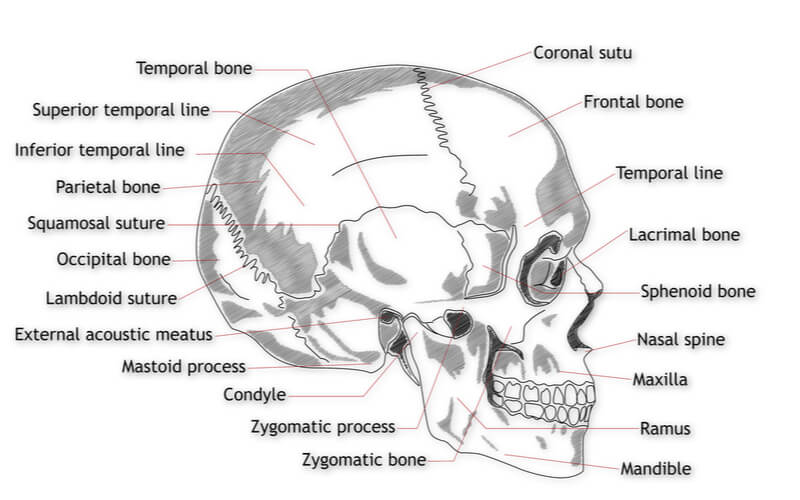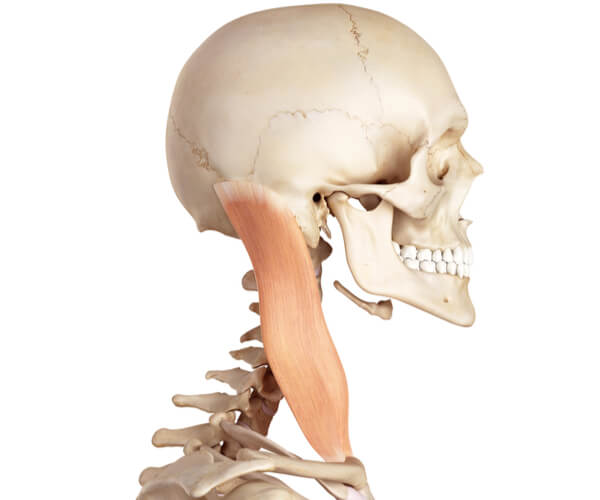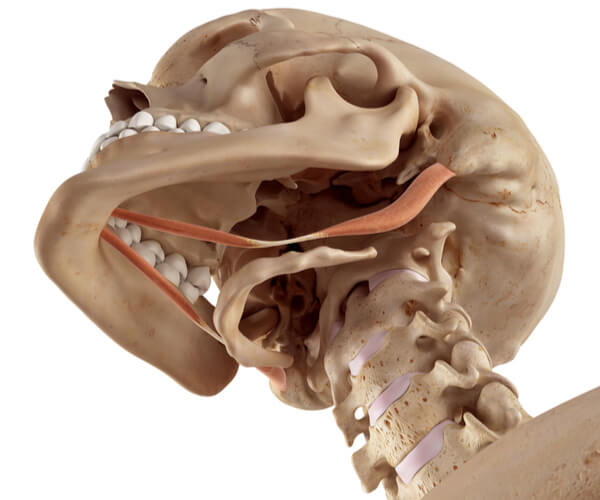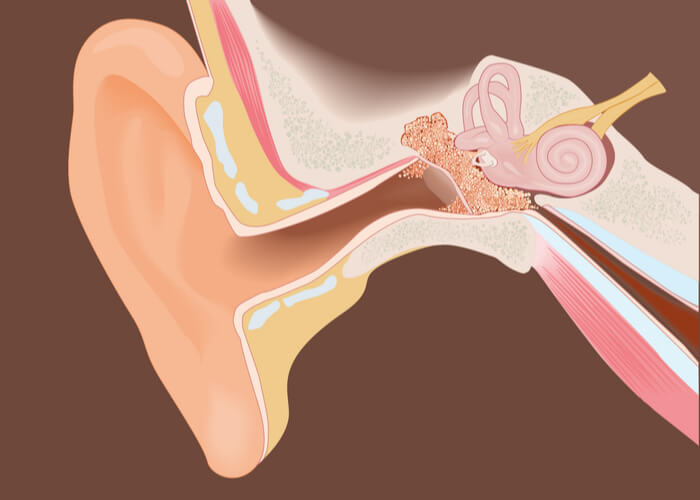Definition
The mastoid process is a smooth conical projection of bone located at the base of the mastoid area of the temporal bone. It allows the attachment of muscles such as the occipitofrontalis muscle, as well as certain muscles of the neck like the sternocleidmastoid and splenius capitis muscles.

Mastoid Process Location
The mastoid process is located on the underside of the mastoid portion of the temporal bone, behind the external auditory meatus. It can be found in front of and behind the ear canal and lateral to the styloid process.
The superior border of the mastoid area joins with the parietal bone and has the petrosquamous suture travelling vertically from it. The posterior border merges with the occipital bone, and the anterior border articulates with the descending part of the squamous area of the temporal bone.
Mastoid Process Anatomy
The mastoid process is a smooth, conical projection of bone which has several structures that allow it to carry out its specific functions. These include:
- Digastric fossa/mastoid notch – a groove located on the medial side of the mastoid process
- Occipital groove – a furrow located medial to the digastric fossa
- Mastoid air cells/Lenoirs – hollow areas present in the superior, inferior, and anterior areas of the mastoid process. They are larger and more irregular in the superior and anterior parts, and diminish in size towards the inferior area

Mastoid Process Function
The mastoid process’ main function is to provide an area of attachment to several important muscles in the head. For instance, it is the attachment site of certain muscles of the neck:
- Sternocleidomastoid muscle – enables the rotation of the head to the contralateral side
- Splenius capitis muscle – responsible for extension, rotation and lateral flexion of the head
- Posterior belly of digastric muscle – responsible for the opening of the jaw upon relaxation of the masseter and temporalis muscles
- Longissimus capitis muscle – responsible for the lateral rotatory flexion of the head
The rough outer surface of the mastoid process also allows the occipitofrontalis muscle to anchor, which wraps the skull from the superior nuchal line to the mastoid process.
In addition to this, the digastric fossa allows for the attachment of the digastric muscle, while the medial occipital groove harbours the attachment of the occipital artery.

The mastoid air cells present in the mastoid process also serve their own function, which is believed to be protection of the temporal bone and the middle and inner ear from trauma, and the regulation of air pressure. They communicate with the middle ear through the mastoid antrum and the aditus ad antrum.
Mastoid Process Disease
Every part of the body can be afflicted by one disease or another, and the mastoid process is no different in this regard. Examples of conditions affecting the mastoid process include:
Mastoiditis
Infection of the middle ear (AKA otitis media) is a rather common ailment, especially in children, and is often easily curable. However, if left untreated, it can spread to the mastoid area through the aditus ad antrum and mastoid antrum, leading to a condition called mastoiditis.
Mastoiditis is an infection of the mucus lining of the mastoid antrum and the mastoid air cells located in the mastoid process. Symptoms of mastoiditis include:
- Swelling or pain/discomfort of mastoid process area (behind the ear)
- Ear discharge
- Fever
- Headache
- Hearing loss

There are several species of bacteria that can cause mastoiditis, the most common culprits being:
- Streptococcus pneumoniae (responsible for pneumonia)
- Streptococcus pyogenes (responsible for scarlet fever)
- Staphylococcus aureus
- Haemophilus influenzae (responsible for the flu)
- Moraxella catarrhalis

If left untreated, mastoiditis can cause a series of complications such as:
- Destruction of the mastoid process
- Meningitis
- Partial or complete hearing loss
- Spread of infection to the brain
Though it can be difficult to treat due to the fact that it is often located rather deep in the bone, mastoiditis is treated with antibiotics which are either injected or taken orally (or sometimes both). If this does not work, surgery may be undertaken to remove part of the mastoid process and drain it in a process called mastoidectomy.
Cholesteatoma
Cholesteatoma is an abnormal growth of skin cells that develops in the middle ear and/or mastoid process. Cholesteatoma may result from a birth defect, though more often than not it is caused by a history of repeated middle ear infections. This growth, though not cancerous, can still cause several issues, and is often characterised by symptoms such as:
- Watery discharge from the ear
- Gradual loss of hearing in affected ear
- Uncomfortable sense of pressure in ear

These symptoms tend to show gradually as the cholesteatoma cyst slowly grows over time, and will worsen if left untreated. This can lead to a number of unpleasant complications, including:
- Ear infection
- Hearing loss
- Tinnitus
- Damage to the facial nerve
- Brain abscess
- Meningitis
As such, it is important to catch and treat cholesteatoma as soon as possible. The only way this is possible is through surgery, where the cholesteatoma is permanently removed while the patient is under general anaesthetic. Antibiotics may also been prescribed in order to combat any infections that may have arisen in the cyst or ear, making it easier to observe the growth traits of the cyst to plan for surgical removal of the cholesteatoma.
